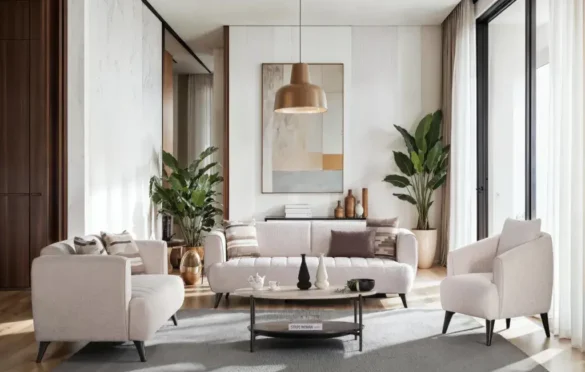Explore this post with:
Curved glass is a key material in modern architecture, blending form and function to create innovative and visually striking structures. Its application spans various domains, including commercial, residential, and cultural architecture. This article delves into what curved glass is, how it is processed, and its impact on architectural design, with examples from real-world projects.
What is Curved Glass?
Curved glass is a form of glass that has been bent into specific shapes, offering greater flexibility and aesthetic appeal compared to flat glass. It allows architects to design structures with flowing, organic forms that were once difficult or impossible to achieve.
Properties of Curved Glass
– Strength: Curved glass is often more durable due to the processing techniques involved, making it resistant to environmental stress.
– Aesthetic Versatility: Its unique form allows for cutting-edge, futuristic designs.
– Light Manipulation: Curved surfaces refract and bend light in ways that enhance energy efficiency and create dynamic visual effects.
How is Curved Glass Processed?
The production of curved glass involves specialized techniques to ensure the desired shape is achieved without compromising its structural integrity. These methods include:
Heat Bending
Heat bending involves heating flat glass to a malleable temperature, typically between 600°C and 700°C. The softened glass is then shaped using a mold and allowed to cool, retaining the curved form. This process is ideal for producing large, smooth curves and is frequently used in façades and skylights.
Cold Bending
In cold bending, flat glass is forced into a curved frame without being heated. While cost-effective, this method is limited to gentle curves and specific glass types that can tolerate the induced stress without cracking.
Lamination
Laminated curved glass is created by bonding layers of curved glass with a plastic interlayer. This technique improves the safety and durability of the glass, making it suitable for applications such as railings, canopies, and glass floors.
Tempering
Tempered curved glass undergoes a heat treatment that increases its strength. This type of glass is often used in areas requiring safety and durability, such as public spaces and transportation hubs.
Applications of Curved Glass in Architecture
Curved glass is widely used in architectural design due to its aesthetic appeal, structural benefits, and ability to enhance energy efficiency. Below are some key applications, illustrated with real-world examples:
Commercial Architecture
Apple Store, Fifth Avenue, New York
The Apple Store in New York features a striking glass cube entrance made with curved glass panels. These panels create a seamless, futuristic aesthetic that aligns with the brand’s minimalist identity. The tempered and laminated curved glass ensures safety and durability, even in high-traffic areas.
30 St Mary Axe (“The Gherkin”), London
This iconic skyscraper in London, designed by Foster + Partners, utilizes curved glass in its façade to achieve its aerodynamic shape. The curved panels not only contribute to its visual appeal but also improve energy efficiency by reducing wind load and optimizing natural light.
Public and Cultural Spaces
Elbphilharmonie, Hamburg
The Elbphilharmonie concert hall features an undulating façade made of uniquely shaped curved glass panels. These panels mimic the waves of the nearby Elbe River, blending the structure into its environment. Additionally, the curved glass enhances the acoustics within the concert hall.
The Louvre Pyramid, Paris
While the Louvre Pyramid primarily uses flat glass, the adjacent entrance canopy incorporates curved glass elements. These features soften the angularity of the pyramid and create a harmonious relationship between the modern addition and the historic museum.
Residential Architecture
Modern Luxury Homes
In residential settings, curved glass is often used to create panoramic views and seamless indoor-outdoor transitions. For example, luxury homes in Los Angeles feature curved glass walls that maximize views of the surrounding landscape while allowing natural light to flood the interiors.
Transportation Hubs
Jewel at Changi Airport, Singapore
The Jewel at Changi Airport boasts a massive glass dome constructed with curved panels. This structure houses an indoor garden and waterfall, combining futuristic design with natural elements. The curved glass dome enhances the sense of openness while allowing natural light to illuminate the space.
King’s Cross Station, London
The redevelopment of King’s Cross Station integrated curved glass into the roof design, offering a modern and inviting atmosphere. The glass diffuses light effectively, creating a bright, open space for travelers.
Advantages of Curved Glass in Architecture
– Aesthetic Innovation: Curved glass allows for the creation of fluid, organic shapes that redefine traditional building design.
– Improved Functionality: It enhances structural strength, light diffusion, and energy efficiency.
– Sustainability: Features such as double-glazing and low-emissivity coatings improve thermal insulation, reducing energy consumption.
– Versatility: Its adaptability makes it suitable for diverse applications, from façades and skylights to balustrades and partitions.
Challenges of Using Curved Glass
While curved glass offers numerous benefits, it also comes with challenges:
– Cost: The production and installation of curved glass are more expensive than flat glass due to the complexity of the manufacturing process.
– Engineering Constraints: Designing and implementing curved glass structures require precise calculations to ensure structural integrity.
– Maintenance: Cleaning and maintaining curved surfaces can be more labor-intensive, particularly on high-rise buildings.
Conclusion
Curved glass has revolutionized architectural design, offering unmatched aesthetic and functional benefits. Its application in iconic buildings like the Apple Store, Elbphilharmonie, and Jewel at Changi Airport showcases its versatility and transformative potential. As technology advances, curved glass will continue to shape the future of architecture, enabling the creation of structures that inspire and innovate. By balancing its advantages with its challenges, architects can use curved glass to push the boundaries of design while addressing practical needs.
In Case You Missed It!
About the Author: archistyladmin
At Architecturesstyle, we’re passionate about smart design, beautiful spaces, and practical tips that help you bring great architecture into everyday life. Whether it's modern home ideas, iconic buildings, or expert advice, our team brings fresh and useful content to readers who love architecture as much as we do.




